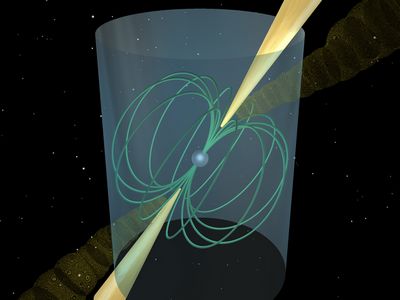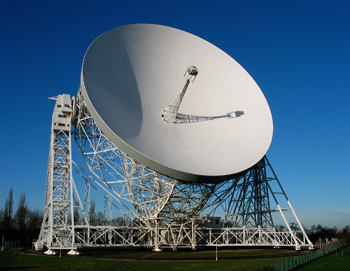An international team of astronomers, including Michael Kramer from the Max Planck Institute for Radio Astronomy (Bonn, Germany) have studied the behaviour of natural cosmic clocks and discovered a way to potentially turn them into the best time keepers in the Universe. The scientists made their breakthrough using decade-long observations from the 76-metre Lovell radio telescope at the University of Manchester's Jodrell Bank Observatory to track the radio signals of an extreme type of star known as pulsars. (Science Express, June, 24th 2010)
 Fig. 1: Schematic view of a pulsar. Pulsars provide the most precise natural cosmic clocks known to date.
Fig. 1: Schematic view of a pulsar. Pulsars provide the most precise natural cosmic clocks known to date.
Image: Michael Kramer / MPI for Radio Astronomy
Radio pulsars have been studied in detail since their discovery in 1967. Their exquisite rotational stability has led to the discovery of the first extra-Solar planets and provided tests for our theories of the Universe. However, the rotational stability is not perfect and, until now, slight irregularities in their rotation have significantly reduced their usefulness as precision tools.
A team led by Professor Andrew Lyne have used observations from the Lovell telescope to explain these variations and to demonstrate a method by which they may be corrected. Professor Lyne explains: "Mankind's best clocks all need corrections, perhaps for the effects of changing temperature, atmospheric pressure, humidity or local magnetic field. Here, we have found a potential means of correcting an astrophysical clock".
The rate at which all pulsars spin is known to be decreasing very slowly. What the team has found is that the deviations arise because there are actually two spin-down rates and not one, and that the pulsar switches between them, abruptly and rather unpredictably. Dr George Hobbs describes the team's second vital discovery "that these changes are associated with a change in the shape of the pulse, or tick, emitted by the pulsar. Because of this, precision measurements of the pulse shape at any particular time indicate exactly what the slowdown rate is and allow the calculation of a "correction". This significantly improves their properties as clocks".

Fig. 2: The Lovell telescope, with a diameter of 76 metres, is still the third-largest fully-steerable telescope in the world. The decade-long pulsar observations described here were performed with the Lovell telescope.
Image: Jodrell Bank Centre for Astrophysics, University of Manchester
As stated by Professor Michael Kramer "These results give a completely new insight into the extreme conditions near neutron stars and offer the potential for improving our already very precise experiments in gravitation". It is hoped that this new understanding of pulsar spin-down will improve the chances that the fastest spinning pulsars will be used to make the first direct detection of ripples, known as gravitational waves, in the fabric of space time. As reported by Professor Ingrid Stairs "Many observatories around the world are attempting to use pulsars in order to detect the gravitational waves that are expected to be created by supermassive binary black holes in the Universe. With our new technique we may be able to reveal the gravitational wave signals that are currently hidden because of the irregularities in the pulsar rotation".
See the website for more details.
http://www.mpg.de/english/illustrationsDocumentation/documentation/pressReleases/2010/pressRelease20100624/index.html(sy)
